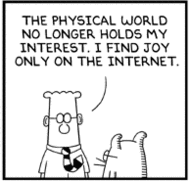Internet
 a.k.a. internet (with lowercase i), the net, the Net
a.k.a. internet (with lowercase i), the net, the Net The most important technological innovation of our generation, the Internet is actually a network of networks. Originally designed by the U.S. Department of Defense so that a communication signal could withstand nuclear war and serve military institutions worldwide, the Internet was first known as the ARPANet, the most robust communication technology.
It is a system of linked computer networks, international in scope, that facilitates data transfer and communication services, such as remote login, file transfer (FTP), electronic mail (e-mail), newsgroups, and the World Wide Web. The Internet greatly extends the reach of each connected computer network (see: network effect, IP).
When you see "internet" written with a lowercase "i," it usually refers to a group of local area networks (LANs) that have been connected by means of a common communications protocol. Many internets exist besides the Internet, including many TCP/IP-based networks that are not linked to the Internet (the Defense Data Network is a case in point). However circa Y2K, users started referring to the Internet with a lowercase i and now both are considered acceptable usage.
Historical perspective: Internet usage is pervasive in the U.S. where there were 220.1 million Internet users as of June 2008 – a 130.9% increase since 2000. These users represent 72.5 % penetration of the entire U.S. population.
Click on "more info" below for a timeline of the Internet!




Edit Word